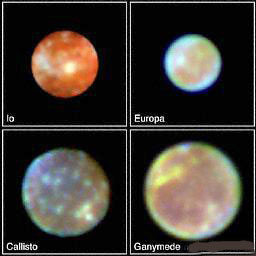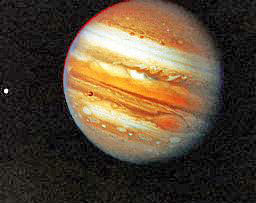|
Chapter Three
IN THE
BEGINNING
In the beginning
God created the heaven and the earth.
And the earth was without form and void
and darkness was upon the face of the deep
And the Spirit of God moved upon the face of the waters.
And God said, Let there be light; and there was light.
"For generations this majestic outline of the manner in which our
world was created has been at the core of Judaism as well of
Christianity and the third monotheistic religion Islam, the latter
two being outgrowths of the first. In the seventeenth century
Archbishop James Ussher of Armagh in Ireland calculated from these
opening verses of Genesis the precise day and even the moment of the
world’s creation, in the year 4004 B.C. Many old editions of the
Bible still carry Ussher’s chronology printed in the margins; many
still believe that Earth and the Solar System of which it is a part
are indeed no older than that. Unfortunately, this belief, known as
Creationism, has taken on science as its adversary; and science,
firmly wed to the Theory of Evolution, has met the challenge and
joined the battle.
"It is regrettable that both sides pay little heed to what has been
known for more than a century - that the creation tales of Genesis
are edited and abbreviated versions of much more detailed
Mesopotamian texts, which were in turn versions of an original
Sumerian text. The battle lines between the Creationists and
Evolutionists - a totally unwarranted demarcation as the evidence
herewith presented will show - are undoubtedly more sharply etched
by the principle of the separation between religion and state that
is embodied in the U.S. Constitution. But such a separation is not
the norm among the Earth’s nations (even in enlightened democracies
such as England), nor was it the norm in antiquity, when the
biblical verses were written down.
"Indeed, in ancient times the
king was also the high priest, the
state had a national god, the temples were the seat of scientific
knowledge, and the priests were the servants. This was so because
when civilization began, the gods who were worshipped - the focus of
the act of being "religious" - were none other than the Anunnaki/Nefilim,
who were the source of all manner of knowledge, alias science on
Earth.
"The merging of state, religion, and science was nowhere more
complete than in Babylon. There the original
Sumerian Epic of
Creation was translated and revised so that Marduk, the Babylonian
national god, was assigned a celestial counterpart.... Nibiru/Marduk....
"....The decipherment of the writing on the clay tablets discovered
in the ruins of ancient Mesopotamia more than a century ago led to
the realization that texts existed that related biblical creation
tales millennia before the Old Testament was compiled.
"....Is the biblical text of creation a religious document, its
contents to be considered only a matter of faith to be believed or
disbelieved; or it is a scientific document, imparting to us
essential knowledge of how things began, in the heavens and on the
Earth? This, of course, is the core of the ongoing argument between
Creationists and Evolutionists. The two camps would have laid down
their arms long ago were they to realize that what the editors and
compilers of the Book of Genesis had done was no different from what
the Babylonians had done: using the only scientific source of their
time, those descendants of Abraham -scion of a royal-priestly family
from the Sumerian capital Ur - also took the Epic of Creation,
shortened and edited it, and made it the foundation of a national
religion glorifying Yahweh "who is in the Heavens and on Earth."
"In Babylon, Marduk was a dual deity. Physically present.... he was
worshipped as Ilu (translated "god" but literally meaning "the Lofty
One").... On the other hand, "Marduk" was a celestial deity, a
planetary god, who in the heavens assumed the attributes, role, and
credit for the primordial creations that the Sumerians had
attributed to Nibiru, the planet whose most frequent symbolic
depiction was that of a winged disk. The Assyrians, replacing
Marduk
with their national god Ashur, combined the two aspects and depicted
Ashur as a god within the winged disc.
"The
Hebrew followed suit, preaching monotheism and recognizing -
based on Sumerian scientific knowledge - the universality of God,
ingeniously solved the problem of duality and of the multitude of
the Anunnaki deities involved in the events on Earth by concocting a
singular-but-plural deity, not an El (the Hebrew equivalent of
Ilu)
but Elohim - a creator who is plural (literally "Gods") and yet
One.... The Hebrew were aware that the deity who could speak to
Abraham and Moses and the celestial Lord whom the Sumerians called
Nibiru were not one and the same scientifically, although all were
part of a universal, everlasting, and omnipotent God - Elohim - in
whose grand design for the universe the path for each planet is its
predetermined "destiny," and what the Anunnaki had done on Earth was
likewise a predetermined mission. Thus was the handiwork of a
universal God manifest in Heaven and on Earth.
"....But to recognize this - that
Genesis represents not just
religion but also science - one must recognize the role of the
Anunnaki and accept that the Sumerian texts are not "myth"
but
factual reports.... only by explaining, as I have repeatedly done in
my writings, that the information on how things began - including
how Man himself was created - indeed did not come from the memory of
the Assyrians or Babylonians or Sumerians but from the knowledge and
science of the Anunnaki/Nefilim. They too, of course could not
"remember" how the Solar System was created or how Nibiru/Marduk
invaded the Solar System, because they themselves were not created
on their planet. But just as our scientists have a good notion of
how the Solar System came about and even how the whole universe came
into being (the favorite theory is that of the Big Bang), the
Anunnaki/Nefilim, capable of space travel 450,000 years ago, surely
had the capacity to arrive at sensible scenarios of creation; much
more so since their planet, acting as a spacecraft that sailed past
all the outer planets, gave them a chance at repeated close looks
that were undoubtedly more extensive than our Voyager "peeks."
"....With the immensity of space as its canvas, here is how the
Mesopotamian version began to draw the primordial picture:
When in the heights Heaven had not been named
And below earth had not been called,
Naught but primordial Apsu, their Begetter,
Mummu, and Tiamat, she who bore them all,
Their waters were mingled together.
No reed had yet been formed,
No marshland had appeared.
"Even in traditional
King James version, the biblical opening is
more matter-of-fact, not an inspirational religious opus but a
lesson in primordial science....
"....With this understanding, the reference in the
Mesopotamian
version to the mingling "waters" of Tiamat ceases to be allegorical
and calls for a factual evaluation. It goes to the question of
plentiful waters of Earth and the biblical assertion (correct, as we
soon will realize) that when the Earth was formed it was completely
covered by water. If water was so abundant even at the moment of
Earth’s creation, then only if Tiamat was also a watery planet could
the half that became Earth be water!
"The watery nature of
Tehom/Tiamat is mentioned in various biblical
references.
"....What was the "wind" of the
Lord that "moved upon the face of
the waters" of Tehom/Tiamat? Not the divine "Spirit" but the
satellite of Nibiru/Marduk that, in the Mesopotamian texts, was
called by that term! Those texts vividly described the flashing and
lightning strokes that burst off Nibiru/Marduk as it closed in on
Tiamat. Applying this knowledge to the biblical text, its correct
reading emerges:
When, in the beginning,
The Lord created the Heaven and the Earth,
The Earth, not yet formed, was in the void,
and there was darkness upon Tiamat.
Then the Wind of the Lord swept upon its waters
and the Lord commanded, "Let there be lightning!"
and there was a bright light.
Then the Wind of the Lord swept upon its waters
and the Lord commanded, "Let there be lightning!"
and there was a bright light.
"The continuing narrative of
Genesis does not describe the ensuing
splitting of Tiamat or the break up of her host of satellites....
"....Genesis picks up the primordial tale here and describes the
forming of the asteroid belt thus:
And Elohim said:
Let there be a firmament in the midst of the waters
and let it divide the waters from the waters.
And Elohim made the Firmament,
dividing the waters which are under the Firmament
from the waters which are above the Firmament.
And Elohim called the Firmament "Heaven."
"....What separated the "upper waters" from the "lower waters," the
Genesis text stresses, was the Raki’a; generally translated
"Firmament," it literally means "Hammered-out Bracelet." Then
Genesis goes on to explain that Elohim called the
Raki’a, the so
called Firmament, Shama’im, "the Heaven" - a name that in its first
use in the Bible consists of the two words Sham and ma’im, meaning
literally "where the waters were." In the creation tale of Genesis,
"the Heaven" was a specific celestial location, where
Tiamat and her
waters had been, where the asteroid belt was hammered out.
"That happened, according to the Mesopotamian texts, when
Nibiru/Marduk
returned to the Place of Crossing - the second phase of the battle
with Tiamat: "Day Two," if you wish, as the biblical narrative does.
Mr. Sitchin at this point explains also how the various planets and
Nibiru/Marduk itself "begat" their satellites, moons or moonlets, as
the "invader" was interacting with the planets in its orbit. Then he
continues:
"....It has taken modern astronomy almost two centuries to find out
what the Sumerians knew 6,000 years ago.
"Even with this knowledge, the biblical statement that the
"Hammered-out Bracelet," the Shama’im - alias "the Heaven," divided
the "waters which are below the Firmament" from the "waters which
are above the Firmament" remained a puzzle. What, in god’s name, was
the Bible talking about?
"....We know - don’t we? - that the
asteroid belt had, indeed, as
the ancient text reported, divided the planets into two groups.
"Below" it are the Terrestrial, or inner Planets; "above" it the
gaseous, or Outer Planets. But except for Earth the former had
barren surfaces and the latter no surfaces at all, and the long-held
wisdom was that neither group (again, excepting Earth) had any
water.
"Well, as result of the missions of unmanned spacecraft to all the
other planets except Pluto, we now know better....
Mercury.... is
too small and too close to the Sun to have retained water, if it
ever had any.
But Venus....
the careful analysis of the results of unmanned probes led the
scientists to answer emphatically, yes. The topographic features
revealed by radar mapping suggested erstwhile oceans and seas. That
such bodies of water might indeed existed on Venus was indicated by
the findings that the "hell-like atmosphere," as some of the
scientists termed it, contained traces of water vapor.
"...."The
lost oceans of Venus" can be traced in its rocks; that was
the conclusion of a joint report of U.S. and Soviet scientists
published in the May 1986 issue of Science. There was indeed water
"below the Firmament," not only on Earth but also on
Venus.
"The latest scientific discoveries have added Mars to the list of
inner planets whose waters corroborate the ancient statement.
"The final NASA report after Viking missions (Mars:
the Viking
Discoveries) concluded that "Mars once had enough water to form a
layer several meters deep over the whole surface of the planet."
This was possible, it is now believed, because Mars (like
Earth)
wobbles slightly as it spins about its axis. This action results in
significant climatic changes every 50,000 years....
"....What had started out as a dry and barren planet has emerged, in
the past decade, as a planet where water was once abundant - not
just passively lying about but flowing and gushing and shaping the
planet’s features. Mars has joined Venus and
Earth in corroborating
the concept of the Sumerian texts of water "below the Firmament," on
the inner planets.
|
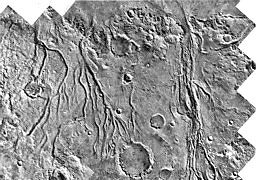 |
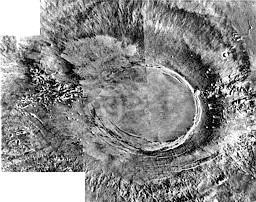
Captions of Mars. Viking Orbiter Mission
|
|
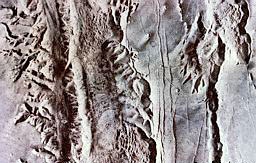 |
"The ancient assertion that the
asteroid belt separated the waters
that are below the Firmament from those that were above it implies
that there was water on the celestial bodies that are located
farther out.
"....Saturn itself, a gaseous giant.... has not yet been penetrated
down to its surface.... But its various moons as well as its
breathtaking rings, are now known to be made, if not wholly then in
large part, of water ice and perhaps even liquid water.
"....What was originally described as "a carousel of bright icy
particles" was revealed, however, by the data from Voyager 1 and
Voyager 2 in 1980 and 1981 to consist of chunks of ice ranging from
boulder size to that of "big houses." We are seeing "a sea of
sparkling ice," JPL’s scientists said. The ice, at some primordial
time, had been liquid water.
"....Pioneer 11 reported in 1979 that the group of
inner moons of
Saturn.... appeared to be "icy bodies" . . . consisting largely of
ice."
"....Voyager 1 also revealed that
Saturn’s outer moons were ice
covered....
|
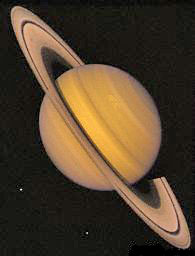
Saturn - From Voyager Probes
|
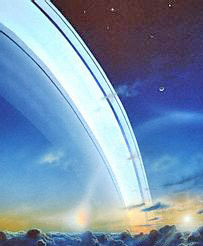
A fantasy: Saturn and its rings
|
"Jupiter was investigated by
Pioneer 10 and Pioneer 11 and by the
two Voyagers.... somewhere farther down inside the thick atmosphere
there is liquid water, the scientists have concluded.
"....the
moons of Jupiter proved more fascinating, revealing, and
surprising than the planet itself.... Io, the closest to Jupiter,
revealed totally unexpected volcanic activity.... The consensus is
that Jupiter Io has "some internal sources of water."
"Europa, like Io, appears to be a rocky body, but its somewhat lower
density suggests that it may contain more internal water than Io.
"....Ganimede, the largest of Jupiter’s moons, appears to be covered
with water ice mixed with rock, suggesting it has undergone
moonquakes that have cracked its crust of frozen ice.... The fourth
Galilean moon, Callisto.... also has an ice-rich crust; under it
there are mush and liquid water surrounding a small, rocky core.
Estimates are that Callisto is more than 50 percent water.
"....Modern science has confirmed the ancient assertion to the
fullest: there indeed have been "waters above the Firmament."
"Jupiter is the Solar System’s largest planet - as large as 1,300
Earths. It contains some 90 percent of the mass of the complete
planetary system of the Sun. As stated earlier, the Sumerians called
it KI.SHAR, "Foremost of the Firm Lands," of the planetary bodies.
Saturn, though smaller than Jupiter, occupies a much larger portion
of the heavens because of its rings, whose "disk" has a diameter of
670,000 miles. The Sumerians called it AN.SHAR, "Foremost of the
Heavens."
Evidently they knew what they were talking about.
Return
Chapter Four
THE MESSENGERS
OF GENESIS
"In 1986 Mankind was treated to a once-in-a-lifetime event: the
appearance of a messenger from the past, a Messenger of Genesis.
It’s name was Halley’s comet.
"....The chain of scientific developments that led
Edmund Halley,
who became British Astronomer Royal in 1720, to determine, during
the years 1695-1705, that the comet he observed in 1682 and that
came to bear his name was a periodic one, the same that had been
observed in 1531 and 1607, involved the promulgation of the laws of
gravitation and celestial motion by Sir Isaac Newton and Newton’s
consulting with Halley about his findings. Until then the theory
regarding comets was that they crossed the heavens in straight
lines, appearing at one end of the skies and disappearing in the
other direction, never to be seen again. But based on Newtonian
laws, Halley concluded that the curve described by comets is
elliptical, eventually bringing these celestial bodies back to where
they had been observed before.
"....Especially because of a comet’s small size, its orbit is easily
perturbed by the gravitational pool of the planets it passes (this
is especially true of Jupiter’s effect). Each time a comet nears the
Sun, its frozen material comes to life; the comet develops a head
and a long tail and begins to lose some of its material as it turns
to gas and vapor. All these phenomena affect the comet’s orbit....
the actual orbit and its period must be recalculated each time the
comet makes an appearance.
"....Most of the returning comets are short-period ones, the
shortest known being that of Encke’s comet, which nears the
Sun and
then returns to a region slightly beyond the asteroid belt in a
little over three years.
Mr. Sitchin names several other comets which are already known to
astronomers, then he continues:
"....When Halley’s comet appeared on its next-to-last passage around
the Sun, in 1910, its course and aspects had been well mapped out in
advance. Still, the Great Comet of 1910, as it was then hailed, was
awaited with great apprehension. There was fear that Earth or
life on
it would not survive the anticipated passage because Earth would be
enveloped in the comet’s tail of poisonous gases.... As the comet
reached its greatest magnitude and brilliance in May 10 1910, its
tail stretching over more than half the vault of heaven King Edward
VII of Great Britain died. On the European continent, a series of
political upheavals culminated in the outbreak of World War I in
1914.
|
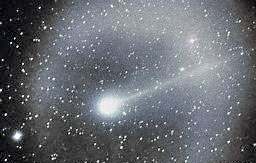
Halley’s Comet as seen in 1986
|
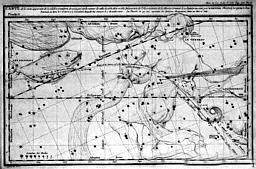
Pass of Halley’s Comet through Pisces and Virgo Constellations in
1759 |
|
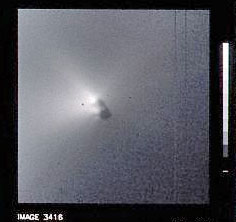
Spacecraft Giotto sent this photograph from Munich’s DFVLR Lab
|
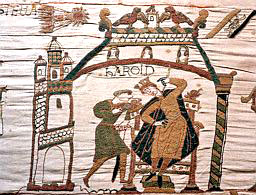
From the Bayeux Tapestry, a warning of a bad Omen to King Harold
(1066) |
"....The year A.D. 66 is considered by astronomers one in which
Halley’s comet made an appearance; they base their
conclusions on
at least two contemporary Chinese observations. That was the year in
which the Jews of Judea launched their Great Revolt against
Rome.
The Jewish historian Josephus (Wars of the Jews, Book VI) blamed the
fall of Jerusalem and the destruction of its Holy Temple on the
misinterpretation by the Jews of the heavenly signs that preceded
the revolt: "a star resembling a sword which stood over the city, a
comet that continued the whole year."
Besides other sightings,
Mr. Sitchin mentions the following:
"....In April 1985,
F.R. Stephenson, K.K.C. Yau and H. Hunger
reported in Nature that a reexamination of Babylonian astronomical
tablets that had been lying in the basement of the British Museum
since their discovery in Mesopotamia more than a century ago, shows
that the tablets recorded the appearance of extraordinary celestial
bodies - probably comets, they (modern scholars) said - in the years
164 B.C. and 87 B.C. The periodicity of seventy-seven years
suggested to these scholars that the unusual celestial bodies were
Halley’s comet.
"The year 164 B.C.... it was the very year in which the
Jews of
Judea, under the leadership of the Maccabees, revolted against
Greek-Syrian domination, recaptured Jerusalem, and purified the
defiled Temple. The Temple rededication ceremony is celebrated to
this day by Jews as the festival of Hanukkah ("Rededication")....
The unusual celestial object.... is reported to have been seen in
the Babylonian month of Kislimu, which is the
Jewish month Kislev
and, indeed, the one in which Hanukkah is celebrated.
"In another instance, the comparison by
Josephus of the comet to a
celestial sword (as it seems to be depicted also in the Bayeux
tapestry) has led some scholars to suggest that the Angel of the
Lord that King David saw "standing between the earth and heaven,
having a sword in his hand stretched out over Jerusalem" (I
Chronicles 21:16) might have been in reality Halley’s comet, sent by
the Lord to punish the king for having conducted a prohibited
census. The time of this incident, circa 1000 B.C., coincides with
one of the years in which Halley’s comet should have appeared.
"In an article published in 1986, I pointed out that the
Hebrew name
for "comet" is Kokhav shavit, a "Scepter star." ... When the
Israelites ended their wanderings in the desert after the Exodus and
began the conquest of Canaan, the Moabite king summoned Bilam (the
seer) to curse the Israelites. But Bilam realizing that the
Israelite advance was divinely ordained, blessed them instead. He
did so, he explained (Numbers 24:17), because he was shown a
celestial vision:
I see it, though not now;
I behold it, though it is not near;
A star of Jacob did course
A scepter of Israel did arise.
"....If, in biblical times, the comet we call
Halley’s was
considered the Scepter Star of Israel, it could explain why the
Jewish revolts of 164 B.C. and A.D. 66 were timed to coincide with
the comet’s appearances....
"....How far back does this messenger of the past go? According to
the Sumerian creation epics, it goes all the way back to the time of
the Celestial Battle. Halley’s comet and its like are truly the
Messengers of Genesis.
"....The planets orbit the Sun in the same direction as did the
original nebula; so do their satellites, or moons; so should also
the debris that either did not coalesce or that resulted from the
disintegration of bodies such as comets and asteroids. Everything
must keep going anticlockwise. Everything must also remain within
the plane of the original disk, which is called the Ecliptic.
"Nibiru/Marduk did not conform to all that. Its orbit, as previously
reviewed, was retrograde - in the opposite direction, clockwise....
"....Where do comets come from, and what causes their odd orbits, of
which the retrograde direction is the oddest in astronomer’s eyes?
After presenting several theories, especially that of the "Oort
Cloud" (Jan Oort) who sums up his study:
"The existence of the huge cloud of comets finds a natural
explanation if comets (and meteorites) are considered as minor
planets escaped, at an early stage of the planetary system, from the
ring of asteroids.
Mr. Sitchin continues:
"It all begins to sound like the
Enuma elish. . . .
"A major and outspoken study on the subject was made public in 1978
by Thomas C. Van Flandern of the U.S. naval Observatory, Washington,
D.C. (Icarus, 36)....
"Summarizing his findings, Van Flandern said thus in 1978:
"The principal conclusion of this paper is that the comets
originated in a breakup event in the inner solar system. In all probability it was the same event which gave rise to the
asteroid belt and which produced most of the meteors visible today."
"He said that it was less certain that the same "breakup event" may
have also given birth to the satellites of Mars and the outer
satellites of Jupiter, and he estimated that the "breakup event"
occurred five million years ago. He has no doubt, however, that the
"breakup event" took place "in the asteroid belt." Physical,
chemical, and dynamic properties of the resulting celestial bodies,
he stated emphatically, indicate "that a large planet did
disintegrate" where the asteroid belt is today.
""The most frequently asked question about this scenario"
Van Flandern wrote, "is ’how can a planet blow up?’ . . . There is
presently," he conceded, "no satisfactory answer to this question."
"No satisfactory answer, that is,
except the Sumerian one: the tale
of Tiamat and Nibiru/Marduk, the Celestial Battle, the breakup of
half of Tiamat, the annihilation of its moons (except for "Kingu"),
and the forcing of their remains into a retrograde orbit....
Many more theories by various scholars follow at this point,
regarding the mass of the supposed destroyed planet, after which
Mr. Sitchin adds:
"....By the acknowledgment of the existence of
Nibiru and his
periodic return to the Place of the Battle, the puzzle of the
"missing matter" finds a solution. It also addresses the theories
that place the accretions of mass by Jupiter at a relative recent
time (millions, not billions, of years ago). Depending on where
Jupiter was at the times of Nibiru’s perihelion, the accretion might
have occurred during various passages of Nibiru and not necessarily
as a one-and-only event at the time of the catastrophic breakup of
Tiamat. Indeed, spectrographic studies of asteroids reveal that some
of them "were heated within the first few hundred million years
after the origin of the solar system" by heat so intense as to melt
them; "iron sank to their centers, forming strong stony-iron cores,
while basaltic lavas floated to their surface, producing minor
planets like Vesta" (Mc Graw-Hill Encyclopedia of Astronomy). The
suggested time of the catastrophe is the very time indicated in The
12th Planet - some 500 million years after the formation of the
Solar System.
"Recent scientific advances in astronomy and
astrophysics go beyond
corroborating the Sumerian cosmogony in regard to the celestial
collision as the common origin of the comets and the asteroids, the
site of that collision (where the remains of the asteroid belt still
orbit) or even the time of the catastrophic event (about 4 billion
years ago). They also corroborate the ancient texts in the vital
matter of water.
"....Tiamat was described as a "watery monster," and the
Mesopotamian texts speak of the handling of her waters by
Nibiru/Marduk:
Half of her he stretched as a ceiling to the Sky,
As a bar at the Place of Crossing he posted it to guard;
Not to allow her waters to escape was its command.
"The concept of an
asteroid belt not only as a divider between the
waters of the planet above and below it but also as a "guardian" of
Tiamat’s own waters is echoed in the biblical verses of
Genesis,
where the explanation is given that the "Hammered-out bracelet" was
also called Shama’im, the place "where the waters were."
....An example is found in Psalm 104, which depicts the
Creator as
the Lord
Who has stretched out the Shama’im as a curtain,
Who in the waters for his ascents put a ceiling.
"These verses are almost a
word-for-word copy of the verses in Enuma
elish; in both instances, the placing of the asteroid belt "where
the waters were."
"....If the asteroids and comets are those remains, should not they
also contain water?
"What would have been a preposterous suggestion when these objects
were deemed "chunks of debris" and "flying sand-banks" has turned
out, as the result of recent discoveries, to be not so preposterous:
the asteroids are celestial objects in which water - yes, water - is
a major component.
Mr. Sitchin mentions the asteroid
Ceres, first to be discovered, and
the celestial body designated 2060 Chiron in which both of them
traces of water were found. Mr. Sitchin then continues:
"Comet Kohoutek (1974) was studied not only from Earth but also with
rockets, from orbiting manned spacecraft (Skylab) and from the
Mariner 10 spacecraft that was on its way to Venus and
Mercury...
"The water finding, as well as that of two complex molecules in the
comet’s tail, are the most significant to date," stated Stephen P.
Moran, who directed the scientific project for NASA.
"....Subsequent cometary observations confirmed these findings.
|
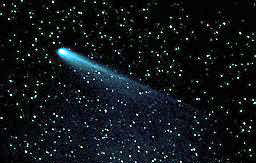
Above:
Comet Kohoutek
Right:
Skylab
|
 |
Mr. Sitchin returns to mentioning
comet Halley and several studies.
He ends with the following:
"And in December 1986, scientists at the
John Hopkins University
announced that evaluation of data collected in March 1986 by the
small Earth-orbiting satellite IUE (International Ultraviolet
Explorer) revealed an explosion on Halley’s Comet that blew 100
cubic feet of ice out of the comet’s nucleus.
"There was
water everywhere on these Messengers of Genesis!
"....In the discoveries concerning the comets and the
asteroids,
something else came to life: the ancient knowledge of Sumer.
Return
Chapter Five
GAIA: THE
CLEAVED PLANET
"Why do we call our planet
"Earth"?
"....The answer lies in the Sumerian texts that relate the arrival
of the first group of Anunnaki/Nephilim on Earth.... They splashed
down in the Arabian Sea, and waded ashore to the edge of the
marshlands that, after the climate warmed up, became the Persian
Gulf. And at the head of the marshlands they established their
first
settlement on a new planet by its name E.RI.DU - "Home in the
Faraway"....
"And so it was that in time the whole settled planet came to be
called after that first settlement - Erde [German],
Erthe [Middle
English], Earth. To this day, whenever we call our planet by its
name, we invoke the memory of that first settlement on Earth;
unknowingly, we remember Eridu and honour the first group of
Anunnaki who established it.
"After Ea had completed the establishment of the first five of the
seven original settlements of the Anunnaki, he was given the
title/epithet EN.KI, "Lord of Earth." But the term
KI, as a root or
verb, was applied to the planet called "Earth" for a reason. It
conveyed the meaning "to cut off, to sever, to hollow out." Its
derivatives illustrate the concept: KI.LA meant "excavation,"
KI.MAH
"tomb," KI.IN.DAR "crevice, fissure." In Sumerian astronomical texts
the term KI was prefixed with the determinative MUL ("celestial
body"). And thus when they spoke of mul.KI, they conveyed the
meaning, "the celestial body that had been cleaved apart."
"By calling Earth KI, the Sumerians thus invoked their cosmogony -
the tale of the Celestial Battle and the cleaving of Tiamat.
"....The intriguing fact is that over time (the Sumerian
civilization was two thousand years old by the time Babylon arose)
the pronunciation of the term ki changed to gi, or sometimes
ge. It
was so carried into the Akkadian and its linguistic branches
(Babylonian, Assyrian, Hebrew), at all times retaining its
geographic or topographic connotation as a cleavage, a ravine, a
deep valley. Thus the biblical term that through Greek translations
of the Bible is read Gehenna stems from the Hebrew
Gai-Hinnom, the
crevice-like narrow ravine outside Jerusalem named after
Hinnom,
where divine retribution shall befall the sinners via an erupting
subterranean fire on Judgement Day.
"We have been taught in school that the component
geo in all the
scientific terms applied to Earth sciences - geo-graphy, geo-metry,
geo-logy, and so on - comes from the Greek Gaia (or
Gaea), their
name for the goddess of Earth. We were not taught where the Greeks
picked up this term or what its real meaning was. The answer is,
from the Sumerian KI or GI.
"....How did
the Cleaved Planet look in the aftermath of the
Celestial Battle, now orbiting as Gaia/Earth? On one side there were
the firm lands that had formed the crust of Tiamat; on the other
side there was a hollow, an immense cleft into which the waters of
the erstwhile Tiamat must have poured. As Hesiod put it,
Gaia (the
half equivalent to Heaven) on one side "brought forth long hills,
graceful haunts of the goddess-Nymphs"; and on the other side "she
bare Pontus, the fruitless deep with its raging swell."
"This is the same picture of the cleaved planet provided by the
Book
of Genesis:
And Elohim said,
"Let the waters under the heaven
be gathered together into one place,
and let the dry land appear."
And it was so.
And Elohim called the dry land "Earth"
and the gathered-together water He called "Seas."
"Earth,
the new Gaia, was taking shape.
"Three thousand years separated Hesiod from the time when the
Sumerian civilization had blossomed out; and it is clear that
through those millennia ancient peoples, including the authors or
compilers of the Book of Genesis, accepted the Sumerian cosmogony.
Called nowadays "myth," "legend," or "religious beliefs," in those
previous millennia it was science - knowledge, the Sumerian
asserted, bestowed by the Anunnaki.
Mr. Sitchin at this
point explains what modern science has to say
today.
Then he continues:
"....Ever since the extensive probes of the
Moon and Mars in the
1960s and 1970s, geophysicists have been puzzled by the paucity of
the Earth’s crust. The crusts of the Moon and of
Mars comprise 10
percent of their masses, but the Earth’s crust comprises less than
one half or 1 percent of the Earth’s land mass.
"....By
analyzing shockwaves from earthquakes, they concluded that
material that belongs in the crust has sunk down and lies some 250
miles below the Earth’s surface. There is enough crustal material
there, these scientists estimated, to increase the thickness of the
Earth’s crust tenfold. But even so, it would have given Earth a
crust comprising no more than about 4 percent of its landmass....
The theory still leaves unanswered the question of what force caused
the crustal material, which is lighter than the mantle’s material,
to "dive" - in the words of the report - hundreds of miles into the
Earth’s interior....
"....Another abnormality of the
Earth’s crust is that it is not
uniform....
"....There are other differences between the
Earth’s crust where the
continents are and where the oceans are.... (These queries are
explained in Mr. Sitchin’s book).
He then continues:
|
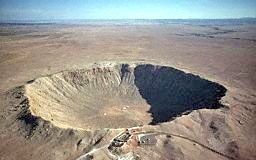
Meteor Crater, Arizona, USA
|
"....Scientists are still hard put to explain the gap of about 500
million years between the age of the Earth (which meteor fragments,
such as those found at Meteor Crater in Arizona, show to be 4.6
billion years) and the age of the oldest rocks thus far found; but
no matter what the explanation, the fact that Earth had its
continental crust at least 4 billion years ago is by now undisputed.
On the other hand, no part of the oceanic crust has been found to be
more than 200 million years old.
"This is a tremendous difference that no amount of speculation about
rising and sinking continents, forming and vanishing seas can
explain....
"....The differences between the continental and oceanic crusts must
have been even greater in earlier times, because the continental
crust is constantly eroded by the forces of nature, and a good deal
of the eroded solids are carried into the oceanic basins, increasing
the thickness of the oceanic crust. Further more, the oceanic crust
is constantly enhanced by the upwelling of molten basaltic rocks and
silicates that flow up from the mantle through faults in the sea
floor. This process, which puts down ever-new layers of oceanic
crust, has been going on for 200 million years, giving the oceanic
crust its present form. What was there at the bottom of the seas
before then? Was there no crust at all, just a gaping "wound" in the
Earth’s surface? And is the ongoing oceanic crust formation akin to
the process of blood clotting, where the skin is pierced and
wounded?
"Is Gaia - a
living planet - trying to heal her wounds?
"The most obvious place of the surface of the Earth where it was so
"wounded" is the Pacific Ocean....
"....What can be said with certainty is that the extent of the
gouging was more extensive, affecting a vastly greater part of the
planet’s surface. The Pacific Ocean at present occupies about a
third of Earth’s surface; but (as far as can be ascertained for the
past 200 millions years) it has been shrinking. The reason for the
shrinkage is that the continents flanking it - the Americas on the
east, Asia and Australia on the west - are moving closer to each
other, squeezing out the Pacific slowly but relentlessly, reducing
its size inch by inch year by year.
"The science and explanations dealing with this process have come to
be known as the Theory of Plate Tectonics....
"....The new science of
plate tectonics, it is now generally
recognized, owes its beginning to Alfred Wegener, a German
meteorologist.... [1915].... Wegener came up with the notion of
Pangaea - a supercontinent, a single huge landmass into which he
could fit all the present continental masses like pieces in a jigsaw
puzzle. Pangaea, which covered about one half of the globe,
Wegener
suggested, was surrounded by the primeval Pacific Ocean....
Mr. Sitchin explains the theories of the drift of the landmass, and
then he continues:
"....How long has continental drift been going on? Was there a
Pangaea?....
"....whether a
superocean surrounded a single mass of dry land or
bodies of water first stretched between several dry lands, is, in
the words of Moorbath, like the chicken-and-the-egg argument: "Which
came first, the continents or the oceans?"
"Modern science thus confirms the scientific notions that were
expressed in the ancient texts, but it cannot see far enough back to
resolve the landmass/ocean sequence. If every modern scientific
discovery seems to have corroborated this or that aspect of ancient
knowledge, why not also accept the ancient answer in this instance:
that the waters covered the face of the Earth and - on the third
"day," or phase - were "gathered into" one side of the Earth to
reveal the dry land. Was the uncovered dry land made up of isolated
continents or one supercontinent, a Pangaea? Although it really
matters not as far as the corroboration of ancient knowledge is
concerned, it is interesting to note that Greek notions of Earth,
although they led to a belief that the Earth was disc-like rather
than a globe, envisioned it as a landmass with a solid foundation
surrounded by waters. This notion must have drawn on earlier and
more accurate knowledge, as most of Greek science did....
"....In addition to the term
Eretz which means both planet "Earth"
and "earth, ground," the narrative in Genesis employs the term
Yabashah - literally, "the dried-out landmass" - when it states that
the waters "were gathered together into one place" to let the
Yabashah appear. But throughout the Old Testament another term,
Tebel, is frequently used to denote that part of Earth that is
habitable, arable, and useful to Mankind (including being a source
of ores). The term Tebel - usually translated as either "the earth"
or "the world" - is mostly employed to indicate the part of Earth
distinct from its watery portions; the "foundations" of this
Tebel
were in juxtaposition to the sea basins. This was best expressed in
the Song of David (2 Samuel 22:16 and Psalm 18:16)
"....With what we know today about the "foundations of the Earth,"
the word Tebel clearly conveys the concept of continents whose
foundations - tectonic plates - are laid in the midst of the waters.
What a thrill to discover the latest geophysical theories echoed in
a 3,000-year-old psalm!
"....Why is the crustal evidence that can be found not older than
about 4 billion years, rather than the 4.6 billion years that is the
presumed age of the Earth and the Solar System?.... In the
discussion of the origins of Earth’s atmosphere, the consensus was
that it did not result from a "continuous outgassing" through
volcanic activity but was (in the words of Raymond Siever of Harvard
University) the result of "a rather early and rather large
outgassing episode . . . a great big belch of the gases that are now
characteristic of the Earth’s atmosphere and sediments." This "big
belch" was also dated to the same time as the catastrophe recorded
by the rocks.
"....the findings of modern science have corroborated the ancient
knowledge. They have also led scientists from all disciplines to
conclude that the only explanation of the way in which Earth’s
landmasses, oceans and atmosphere have evolved is to assume a
cataclysm occurring about four billion years ago - about half a
billion years after the initial formation or Earth as part of the
Solar System.
"What was that cataclysm? Mankind has possessed the
Sumerian answer
for six thousand years: the Celestial Battle between Nibiru/Marduk
and Tiamat.
"In that Sumerian cosmogony, the members of the Solar System were
depicted as celestial gods, male and female, whose creation was
compared to birth, whose existence was that of living creatures.
|

"Mother Earth" viewed
from space |
"....For a long time this view of the planets, and especially of
Tiamat, as living entities that could be born and could die has been
dismissed as primitive paganism. But the exploration of the
planetary system in recent decades has, in fact, revealed words for
which the word "alive" has been repeatedly used. That
Earth itself is a living planet was forcefully put forth
as the
Gaia Hypothesis
by James E. Lovelock in the 1970s (Gaia - A New Look at Life on
Earth) and was most reinforced by him in The Ages of Gaia: A
Biography of Our Living Earth. It is a hypothesis that views the
Earth and the life that has evolved upon it as a single organism;
Earth is not just an inanimate globe upon which there is life; it is
a coherent if complex body that is itself alive through its mass and
land surface, its oceans and atmosphere, and through the flora and
fauna which it sustains and in which turn sustain Earth. "The
largest living creature on Earth," Lovelock wrote, "is the Earth
itself." And in that he admitted, he was revisiting the ancient
"concept of Mother Earth, or as the Greeks called her long ago,
Gaia."
"But in fact he had gone back to
Sumerian times, to their ancient
knowledge of the planet that was cleaved apart.
Return
|





